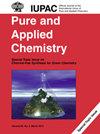电化学传感应用中铊与功能化多壁碳纳米管相互作用的计算研究
IF 2
4区 化学
Q3 CHEMISTRY, MULTIDISCIPLINARY
引用次数: 0
摘要
铊(Tl)是一种重毒性元素,可导致多种健康问题。世界卫生组织和美国环保署规定了饮用水中铊的最大允许含量,超过这一含量就会对人体造成危害,因此确定我们环境中的铊含量至关重要。多壁碳纳米管(MWCNTs)具有大表面积和高导电性的特点,可以很容易地官能化为选择性基团,因此是铊传感的首选材料。之前的实验结果表明,在优化条件下使用伏安法,铊能选择性地与 3-氨基-1,2,4-三唑-5-硫醇官能化的 MWCNTs(T-MWCNTs)相互作用,检测限为 1.29 μg L-1,线性范围为 10-100 μg L-1。在实际水样中,使用上述功能化 MWCNTs 纳米复合材料制作的电化学传感器表现出较高的重现性和回收率。分子识别以及化学和生物过程的结果是由分子间的非共价相互作用决定的。研究这些相互作用如何影响结合偏好,对于加深我们对这些事件的理解至关重要。在这里,我们利用量子化学计算研究了 Tl 和 T-MWCNT 复合物的结构。我们的结果表明,Tl-T-MWCNTs 的最有利复合物涉及 Tl 与氮孤对子的强相互作用,以及 T-MWCNTs 的酰胺连接的氧孤对子提供的额外稳定相互作用。此外,我们还观察到 T-MWCNT 中的硫醇基团因其酸性很容易发生去质子化作用。分子间的非共价相互作用会影响化学和生物过程以及分子识别。该结构的吸附能为负值(-1.53 eV),表明 Tl 与 T-MWCNT 之间的相互作用过程是自发的。本文章由计算机程序翻译,如有差异,请以英文原文为准。
Computational investigation of thallium interactions with functionalized multi-walled carbon nanotubes for electrochemical sensing applications
Thallium (Tl) is a heavy toxic element which can cause several health issues. WHO and EPA have set a maximum permissible limit for thallium in drinking water above which it is hazardous, so its determination in our environment becomes crucial. Multi-walled carbon nanotubes (MWCNTs) are preferred for use in thallium sensing due to their large surface area and high conductivity, which allow them to be readily functionalized to selective groups. Previous experimental results showed that Tl selectively interacted with the MWCNTs functionalized with 3-amino-1,2,4-triazole-5-thiol (T-MWCNTs) with a limit of detection of 1.29 μg L−1 and linear range 10–100 μg L−1 by using voltammetry under optimized conditions. In actual water samples, the electrochemical sensor fabricated with the above-mentioned functionalized MWCNTs nanocomposite demonstrated high reproducibility and recovery. Molecular recognition and the outcomes of chemical and biological processes are shaped by non-covalent interactions among molecules. It is essential to investigate how these interactions impact binding preferences to enhance our understanding of these events. Here, we examine the structures of complexes of Tl and T-MWCNTs using quantum chemical calculations. Our results show that the most favourable complex of Tl-T-MWCNTs involve strong interaction of Tl with the nitrogen lone pair and additional stabilising interaction provided by the oxygen lone pair of amide linkage of T-MWCNTs. Moreover, we observed that the thiol group within T-MWCNTs readily undergoes deprotonation due to its acidic nature. Non-covalent interactions among molecules influence chemical and biological processes and molecular recognition. To improve our knowledge of these events, it is important to explore the ways in which these interactions affect binding preferences The negative value of adsorption energy (−1.53 eV) of this structure suggested that the interaction process between Tl and T-MWCNTs is spontaneous.
求助全文
通过发布文献求助,成功后即可免费获取论文全文。
去求助
来源期刊

Pure and Applied Chemistry
化学-化学综合
CiteScore
4.00
自引率
0.00%
发文量
60
审稿时长
3-8 weeks
期刊介绍:
Pure and Applied Chemistry is the official monthly Journal of IUPAC, with responsibility for publishing works arising from those international scientific events and projects that are sponsored and undertaken by the Union. The policy is to publish highly topical and credible works at the forefront of all aspects of pure and applied chemistry, and the attendant goal is to promote widespread acceptance of the Journal as an authoritative and indispensable holding in academic and institutional libraries.
 求助内容:
求助内容: 应助结果提醒方式:
应助结果提醒方式:


